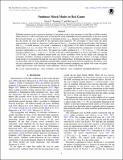Nonlinear Mixed Modes in Red Giants
Author(s)
Weinberg, Nevin N.; Arras, Phil
DownloadPublished version (1.130Mb)
Terms of use
Metadata
Show full item recordAbstract
Turbulent motions in the convective envelope of red giants excite a rich spectrum of solar-like oscillation modes. Observations by CoRoT and Kepler have shown that the mode amplitudes increase dramatically as the stars ascend the red giant branch, i.e., as the frequency of maximum power, ν max , decreases. Most studies nonetheless assume that the modes are well described by the linearized fluid equations. We investigate to what extent the linear approximation is justified as a function of stellar mass M and ν max , focusing on dipole mixed modes with frequency near ν max . A useful measure of a mode's nonlinearity is the product of its radial wavenumber and its radial displacement, k r ξ r (i.e., its shear). We show that , implying that the nonlinearity of mixed modes increases significantly as a star evolves. The modes are weakly nonlinear () for and strongly nonlinear () for , with only a mild dependence on M over the range we consider (1.0-2.0 M o ). A weakly nonlinear mixed mode can excite secondary waves in the stellar core through the parametric instability, resulting in enhanced, but partial, damping of the mode. By contrast, a strongly nonlinear mode breaks as it propagates through the core and is fully damped there. Evaluating the impact of nonlinear effects on observables such as mode amplitudes and linewidths requires large mode network simulations. We plan to carry out such calculations in the future and investigate whether nonlinear damping can explain why some red giants exhibit dipole modes with unusually small amplitudes, known as depressed modes.
Date issued
2019-03Department
Massachusetts Institute of Technology. Department of Physics; MIT Kavli Institute for Astrophysics and Space ResearchJournal
Astrophysical Journal
Publisher
American Astronomical Society
Citation
Weinberg, Nevin N. and Phil Arras. "Nonlinear Mixed Modes in Red Giants." Astrophysical Journal © 2019 The American Astronomical Society 873, 1 (March 2019): 67 © 2019 The American Astronomical Society
Version: Final published version
ISSN
1538-4357